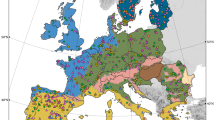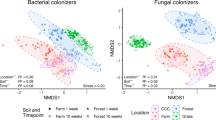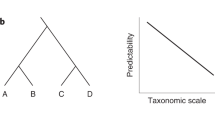Abstract
Analysis of patterns in the distribution of taxa can provide important insights into ecological and evolutionary processes. Microbial biogeographic patterns almost always appear to be weaker than those reported for plant and animal taxa. It is as yet unclear why this is the case. Some argue that microbial diversity scales differently over space because microbial taxa are fundamentally different in their abundance, longevity and dispersal abilities. Others have argued that differences in scaling are an artifact of how we assess microbial biogeography, driven, for example, by differences in taxonomic resolution, spatial scale, sampling effort or community activity/dormancy. We tested these alternative explanations by comparing bacterial biogeographic patterns in soil to those of trees found in a forest in Gabon. Altering taxonomic resolution, excluding inactive individuals, or adjusting for differences in spatial scale were insufficient to change the rate of microbial taxonomic turnover. In contrast, we account for the differences in spatial turnover between these groups by equalizing sampling extent. Our results suggest that spatial scaling differences between microbial and plant diversity are likely not due to fundamental differences in biology, and that sampling extent should be taken into account when comparing the biogeographic patterns of microorganisms and larger organisms.
Similar content being viewed by others
Log in or create a free account to read this content
Gain free access to this article, as well as selected content from this journal and more on nature.com
or
References
Lomolino MV, Riddle BR, Brown JH. Biogeography 3rd ed. In: Lomolino MV, Riddle BR, & Brown JH, editors. Sunderland, MA: Sinauer Associates Sunderland; Species and Extinction, Chapter 7. 2006.
Green JL, Holmes AJ, Westoby M, Oliver I, Briscoe D, Dangerfield M, et al. Spatial scaling of microbial eukaryote diversity. Nature. 2004;432:747–50.
Hillebrand H, Watermann F, Karez R, Berninger UG. Differences in species richness patterns between unicellular and multicellular organisms. Oecologia. 2001;126:114–24.
Horner-Devine MC, Lage M, Hughes JB, Bohannan BJM. A taxa-area relationship for bacteria. Nature. 2004;432:750–3.
Zhou J, Kang S, Schadt CW, Garten CT. Spatial scaling of functional gene diversity across various microbial taxa. Proc Natl Acad Sci USA. 2008;105:7768–73.
Diamond JM. The island dilemma: lessons of modern biogeographic studies for the design of natural reserves. Biol Conserv. 1975;7:129–46.
Simberloff D, Abele LG. Refuge design and island biogeographic theory: effects of fragmentation. Am Nat. 1982;120:41–50.
Soule ME, Simberloff D. What do genetics and ecology tell us about the design of nature reserves? Biol Conserv. 1986;35:19–40.
Finlay BJ. Global dispersal of free-living microbial eukaryote species. Science. 2002;296:1061–3.
Martiny JBH, Eisen JA, Penn K, Allison SD, Horner-devine MC. Drivers of bacterial β-diversity depend on spatial scale. Proc Natl Acad Sci USA. 2011;108:7850–54.
Woodcock S, Curtis TP, Head IM, Lunn M, Sloan WT. Taxa-area relationships for microbes: the unsampled and the unseen. Ecol Lett. 2006;9:805–12.
Fuhrman JA, Campbell L. Marine ecology: microbial microdiversity. Nature. 1998;393:410–11.
Storch D, Šizling AL. The concept of taxon invariance in ecology: do diversity patterns vary with changes in taxonomic resolution? Folia Geobot. 2008;43:329–44.
Tiedje JM. Approaches to the comprehensive evaluation of prokaryote diversity of a habitat. In: D. Allsopp, D.L. Hawksworth and R.R. Colwell, editors, Microbial diversity and ecosystem function. CAB International, Wallingford, England; 1995; p. 73–97.
Lennon JT, Jones SE. Microbial seed banks: the ecological and evolutionary implications of dormancy. Nat Rev Microbiol. 2011;9:119–30.
Blagodatskaya E, Kuzyakov Y. Active microorganisms in soil: critical review of estimation criteria and approaches. Soil Biol Biochem. 2013;67:192–211.
Pace NR. A molecular view of microbial diversity and the biosphere. Science. 1997;276:734–40.
Hanson CA, Fuhrman JA, Horner-Devine MC, Martiny JBH. Beyond biogeographic patterns: processes shaping the microbial landscape. Nat Rev Microbiol. 2012;10:497–506.
Locey KJ. Synthesizing traditional biogeography with microbial ecology: the importance of dormancy. J Biogeogr. 2010;37:1835–41.
Franklin RB, Mills AL. Multi-scale variation in spatial heterogeneity for microbial community structure in an eastern Virginia agricultural field. FEMS Microbiol Ecol. 2003;44:335–46.
Nekola JC, White PS. The distance decay of similarity in biogeography and ecology. J Biogeogr. 1999;26:867–78.
Preston FW. Time and space and the variation of species. Ecology. 1960;41:612–27.
Soininen J, McDonald R, Hillebrand H. The distance decay of similarity in ecological communities. Ecography. 2007;30:3–12.
Tuomisto H, Ruokolainen K, Yli-halla M. Dispersal, environment, and floristic variation of Western Amazonian forests. Science. 2003;299:241–5.
Condit R, Pitman N, Leigh EG, Chave J, Terborgh J, Foster RB, et al. Beta-diversity in tropical forest trees. Science. 2002;295:666–9.
Martiny JBH, Bohannan BJM, Brown JH, Colwell RK, Fuhrman JA, Green JL. et al. Microbial biogeography: putting microorganisms on the map. Nat Rev Microbiol. 2006;4:102–12.
Papke RT, Ramsing NB, Bateson MM, Ward DM. Geographical isolation in hot spring cyanobacteria. Environ Microbiol. 2003;5:650–9.
Whitaker RJ, Grogan DW, Taylor JW. Geographic barriers isolate endemic populations of hyperthermophilic archaea. Science. 2003;301:976–8.
Bell T. Experimental tests of the bacterial distance-decay relationship. ISME J. 2010;4:1357–65.
Cam E, Nichols JD, Hines JE, Sauer JR, Alpizar-Jara R, Flather CH. Disentangling sampling and ecological explanations underlying species-area relationships. Ecology. 2002;83:1118–30.
Morlon H, Chuyong G, Condit R, Hubbell S, Kenfack D, Thomas D, et al. A general framework for the distance-decay of similarity in ecological communities. Ecol Lett. 2008;11:904–17.
Fierer N, Jackson RB. The diversity and biogeography of soil bacterial communities. Proc Natl Acad Sci USA. 2006;103:626–31.
Zinger L, Boetius A, Ramette A. Bacterial taxa-area and distance-decay relationships in marine environments. Mol Ecol. 2014;23:954–64.
Lee ME, Alonso A, Dallmeier F, Campbell P, Pauwels OSG. The gamba complex of protected areas: an illustration of Gabon’s Biodiversity. Bull Biol Soc Wash. 2006;12:229–42.
Memiaghe HR, Lutz JA, Korte L, Alonso A, Kenfack D. Ecological importance of small-diameter trees to the structure, diversity and biomass of a tropical evergreen forest at Rabi, Gabon. PLoS ONE. 2016;11:e0154988.
Fadrosh DW, Ma B, Gajer P, Sengamalay N, Ott S, Brotman RM, et al. An improved dual-indexing approach for multiplexed 16S rRNA gene sequencing on the Illumina MiSeq platform. Microbiome. 2014;2:1–7.
Kozich JJ, Westcott SL, Baxter NT, Highlander SK, Schloss PD. Development of a dual-index sequencing strategy and curation pipeline for analyzing amplicon sequence data on the MiSeq Illumina sequencing platform. Appl Environ Microbiol. 2013;79:5112–20.
Dean WE. Determination of carbonate and organic matter in calcareous sediments and sedimentary rocks by loss on ignition: comparison with other methods. J Sediment Res. 1974;44:242–248.
Kamprath EJ, Watson ME. Conventional soil and tissue tests for assessing the phosphorus status of soils. The role of phosphorus in agriculture; In: F.E. Khasawneh, E.C. Sample, E.J. Kamprath editor, American Society of Agronomy, Crop Science Society of America, Soil Science Society of America, Madison, WI, USA. 1980. p. 433–69.
Olsen SR. Estimation of available phosphorus in soils by extraction with sodium bicarbonate. Washington: United States Department of Agriculture Circular; 1954.
Fox RL, Olson RA, Rhoades HF. Evaluating the sulfur status of soils by plant and soil tests. Soil Sci Soc Am J. 1964;28:243–6.
Chapman HD. Cation-exchange capacity. In: Methods of soil analysis. American Society of Agronomy, Soil Science Society of America; C.A. Black. Madison, WI, USA: 1965. p. 891–901.
Caporaso JG, Kuczynski J, Stombaugh J, Bittinger K, Bushman FD, Costello EK, et al. QIIME allows analysis of high- throughput community sequencing data Intensity normalization improves color calling in SOLiD sequencing. Nat Methods. 2010;7:335–6.
Edgar RC. UPARSE: highly accurate OTU sequences from microbial amplicon reads. Nature. 2013;10:996–1000.
Edgar RC. Search and clustering orders of magnitude faster than BLAST. Bioinformatics. 2010;26:2460–1.
Vienna, Austria, R Foundation for statistical computing. Development Core Team. R: a language and environment for statistical computing; 2010.
Oksanen J, Blanchet FG, Roeland K, Legendre P, Minchin P, O’Hara RB, et al. vegan: Community ecology package; 2015, https://CRAN.R-project.org/package=vegan.
Jost L, Chao A, Chazdon RL. Compositional similarity and Beta diversity. In: Magurran AE, McGill B, eds.. Biological diversity: frontiers in measurement and assessment.. Oxford: Oxford University Press; 2011. p. 66–84.
Jurasinski G, Retzer V. simba: A collection of functions for similarity analysis of vegetation data; 2012, https://CRAN.R-project.org/package=simba.
Gower JC. A general coefficient of similarity and some of its properties. Biometrics. 1971;27:857–71.
Maechler, M., Rousseeuw, P., Struyf, A., Hubert, M., Hornik, K. (2016). cluster: Cluster Analysis Basics and Extensions.
Green J, Bohannan BJM. Biodiversity scaling relationships: are microorganisms fundamentally different? In: Storch D, Marquet PA, Brown JH, eds.. Scaling biodiversity. Cambridge: Cambridge University Press; 2007. p. 129–49.
Barnard RL, Osborne CA, Firestone MK. Responses of soil bacterial and fungal communities to extreme desiccation and rewetting. ISME J. 2013;7:2229–41.
Bissett A, Richardson AE, Baker G, Wakelin S, Thrall PH. Life history determines biogeographical patterns of soil bacterial communities over multiple spatial scales. Mol Ecol. 2010;19:4315–27.
Rosenzweig ML. Species diversity in space and time. Cambridge: Cambridge University Press; 1995.
Sloan WT, Lunn M, Woodcock S, Head IM, Nee S, Curtis TP. Quantifying the roles of immigration and chance in shaping prokaryote community structure. Environ Microbiol. 2006;8:732–40.
Gaston KJ, Blackburn TM, Lawton JH. Interspecific abundance-range size relationships: an appraisal of mechanisms. J Anim Ecol. 1997;66:579–601.
Östman Ö, Drakare S, Kritzberg ES, Langenheder S, Logue JB, Lindström ES. Regional invariance among microbial communities. Ecol Lett. 2010;13:118–27.
Brown JH. On the relationship between abundance and distribution of species. Am Nat. 1984;124:255–79.
Thompson K, Hodgson JG, Gaston KJ. Abundance–range size relationships in the herbaceous flora of central England. J Ecol. 1998;86:439–48.
Navarrete AA, Venturini AM, Meyer KM, Klein AM, Tiedje JM, Bohannan BJ. et al. Differential response of Acidobacteria subgroups to forest-to-pasture conversion and their biogeographic patterns in the western Brazilian Amazon. Front Microbiol. 2015;6:1–10.
Green JL, Bohannan BJM, Whitaker RJ. Microbial biogeography: from taxonomy to traits. Science. 2008;320:1039–43.
Nelson MB, Martiny AC, Martiny JBH. Global biogeography of microbial nitrogen-cycling traits in soil. Proc Natl Acad Sci USA. 2016;113:8033–40.
Louca S, Parfrey LW, Doebli M. Decoupling function and taxonomy in the global ocean microbiome. Science. 2016;353:1272–7.
Acknowledgements
We thank the Government of Gabon, Centre National de la Recherche Scientifique et Technologique for permission (Permit No 866/MENESTFPRSCJS/CENAREST/CG/CAB) to conduct this study. We also thank P. Voua Otomo, G. Moussavou, P. Bissiemou, D. Nguema, E. Mounoumoulossi Nougnoungou, and W. Mbadinga-Mbadinga for their help in collecting samples. The Smithsonian Conservation Biology Institute, the Gabon-Oregon Transnational Center on Environment and Development, and Shell Gabon provided financial and logistical support. This is contribution # 154 of the Gabon Biodiversity Program.
Author contributions
KMM and BJMB designed research. KMM, BJMB, and LK collected samples. KMM and HM performed analysis. KMM wrote the manuscript with inputs from all authors.
Author information
Authors and Affiliations
Corresponding author
Ethics declarations
Conflict of interest
The authors declare that they have no conflict of interest.
Electronic supplementary material
Rights and permissions
About this article
Cite this article
Meyer, K.M., Memiaghe, H., Korte, L. et al. Why do microbes exhibit weak biogeographic patterns?. ISME J 12, 1404–1413 (2018). https://doi.org/10.1038/s41396-018-0103-3
Received:
Revised:
Accepted:
Published:
Issue date:
DOI: https://doi.org/10.1038/s41396-018-0103-3
This article is cited by
-
Differential roles of deterministic and stochastic processes in structuring soil bacterial ecotypes across terrestrial ecosystems
Nature Communications (2025)
-
Inference from eDNA-based field distributions vs laboratory analysis of isolated strains: physiological performance of non-marine Antarctic biota
Polar Biology (2025)
-
Assembly processes of both abundant and rare microbial taxa in response to diverse reclamation patterns in an open-cast coal mining
Plant and Soil (2025)
-
Linking watershed formation with the phylogenetic distribution of a soil microscopic fungus in Yunnan Province, China
BMC Microbiology (2024)
-
Biotic homogenization, lower soil fungal diversity and fewer rare taxa in arable soils across Europe
Nature Communications (2024)



